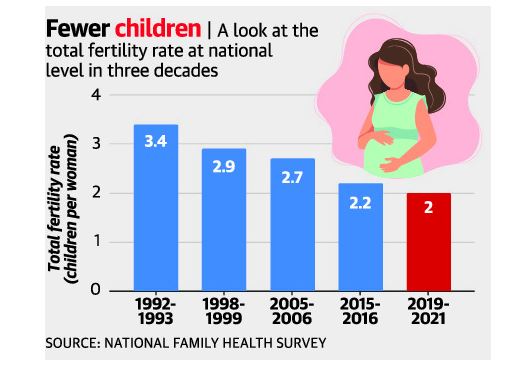Context:
The Total Fertility Rate (TFR), the average number of children per woman, has further declined from 2.2 to 2.0 at the national level between National Family Health Survey (NFHS) 4 and 5.

Relevance:
GS-II: Social Justice and Governance (Issues related to Health, Government Policies and Interventions)
Dimensions of the Article:
- About National Family Health Survey
- How often is the NFHS conducted?
- Comparison between NFHS-5 and NFHS-4
- Areas of concern
- Highlights of the NFHS 5 Part-II
About National Family Health Survey:
- It is a large-scale, multi-round survey conducted in a representative sample of households throughout India and provides information on population, health, and nutrition for each state/union territory (UT).
- The International Institute for Population Sciences (IIPS) Mumbai, is the nodal agency for providing coordination and technical guidance for the survey.
- The survey provides state and national information for India on:
- Fertility
- Infant and child mortality
- The practice of family planning
- Maternal and child health
- Reproductive health
- Nutrition
- Anemia
- Utilization and quality of health and family planning services
- It provides essential data on health and family welfare needed by the Ministry of Health and Family Welfare and other agencies.
- It provides information on important emerging health and family welfare issues.
How often is the NFHS conducted?
The below information gives details on the round and the year it was conducted.
- First Round of NFHS conducted in 1992-93
- Second Round of NFHS conducted in 1998-99
- Third Round of NFHS conducted in 2005-06
- Fourth Round of NFHS conducted in 2015-16
- Fifth Round of NFHS conducted in 2018-19
Comparison between NFHS-5 and NFHS-4
- NFHS-5 includes some new topics, such as preschool education, disability, access to a toilet facility, death registration, bathing practices during menstruation, and methods and reasons for abortion.
- For the first time since the NFHS 1992-93 survey, the sex ratio is slightly higher among the adult population.
- It is also for the first time in 15 years that the sex ratio at birth has reached 929 (it was 919 for 1,000 males in 2015-16).
- The total fertility rate has also dropped from 2.2 per cent to a replacement rate of 2 per cent.
- It appears that states which were already experiencing a decline in fertility rates have continued to do so, without much change in the trends in the higher fertility states.
- There has been an appreciable improvement in general literacy levels and in the percentage of women and men who have completed 10 years or more of schooling, which has reached 41 per cent and 50.2 per cent respectively.
- There has also been a consistent drop in neonatal, infant and child mortality rates — a decrease of around 1 per cent per year for neonatal and infant mortality and a 1.6 per cent decrease per year for under five mortality rate.
- Between NFHS 4 and NFHS 5, the percentage of children below five years who are moderately underweight has reduced from 35.8 per cent to 32.1 per cent.
- Moderately stunted children have fallen from 38.4 per cent to 35.5 per cent, Moderately wasted from 21 per cent to 19.3 per cent.
- Severely wasted have increased slightly from 7.5 per cent to 7.7 per cent.
Areas of concern
- India has become a country with more anemic people since NFHS-4 (2015-16), with anemia rates rising significantly across age groups, ranging from children below six years, adolescent girls and boys, pregnant women, and women between 15 to 49 years.
- Adverse effects of anemia affect all age groups —
- Lower physical and cognitive growth and alertness among children and adolescents.
- Lesser capacity to learn and play, directly impacting their future potential as productive citizens.
- Lower capacity to work and quick fatigue for adolescents and adults, translates into lower work output and lesser earnings.
- Anemia among adolescent girls (59.1 per cent) advances to maternal anaemia and is a major cause of maternal and infant mortality and general morbidity and ill health in a community.
Highlights of the NFHS 5 Part-II
(a) Fertility Rate
- Only five states — Bihar (2.98), Meghalaya (2.91), Uttar Pradesh (2.35), Jharkhand (2.26), and Manipur (2.17) — have fertility rates above the replacement threshold of 2.1.
(b) Institutional Births
- Institutional births grew from 79 percent to 89 percent in India, with 87 percent of births in rural regions and 94 percent in urban areas being delivered in institutions.
- According to the NFHS-5, more than three-quarters (77%) of children aged 12 to 23 months were fully immunised, compared to 62% in the NFHS-4.
- Stunting among children under the age of five has decreased slightly throughout the country over the last four years, from 38 percent to 36 percent.
- In 2019-21, stunting is higher among children in rural regions (37 percent) than urban areas (30 percent).
c) Making decisions
- Married women’s participation in three home decisions (regarding her own health care, important household purchases, and visits to her family or relatives) is high, ranging from 80 percent in Ladakh to 99 percent in Nagaland and Mizoram.
- The disparities between rural (77%) and urban (81%) areas are determined to be minor.
- In the last four years, the percentage of women with a bank or savings account has risen from 53% to 79 percent.
d) Obesity
- In most States/UTs, the prevalence of overweight or obesity has grown in NFHS-5 compared to NFHS-4. It grew from 21% to 24% among women and 19% to 23% among men at the national level.
- Over a third of women in Kerala, Andaman and Nicobar Islands, Andhra Pradesh, Goa, Sikkim, Manipur, Delhi, Tamil Nadu, Puducherry, Punjab, Chandigarh, and Lakshadweep (34-46%) are overweight or obese.
-Source: The Hindu



